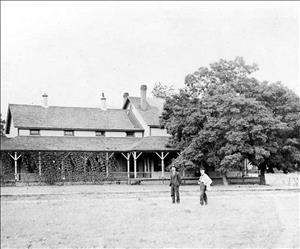In 1882, President Chester A. Arthur (1829-1886) formally establishes Fort Spokane, the U.S. Army’s last frontier outpost in the Northwest, at the junction of the Spokane and Columbia rivers in what is now Lincoln County. The post is intended to confine the Colville and Spokane Indians on reservations north and west of the rivers, and remove them from the fertile farmland to the southeast, around the developing city of Spokane. The Indians do not forcibly resist, and the troops stationed at the fort over the two decades of its existence never fire a shot in anger.
In the late 1870s, Indian resistance to settlers encroaching on their lands led to war in other parts of the Northwest, and settlers among the Spokane and Colville Indians in Eastern Washington were afraid that war might break out there also. The Colville and Spokane Salish peoples had been farming the rich lands of the region for several generations, since fur traders in the early 1800s introduced wheat, fruit trees, chickens, pigs, and cattle. By the late 1870s, the Northern Pacific Railroad was advertising the region’s farming potential to whites, and the settlers who poured in wanted the Salish who were already farming moved off the land and onto reservations being set aside across the Spokane and Columbia rivers. To accomplish this, and to ensure protection should the Indians resist, the settlers sought assistance from the Army.
Camp Spokane
Army troops under Lt. Col. Henry Clay Merriam, a civil war veteran from Maine, first occupied the site at the junction of the Columbia and Spokane rivers in 1880. The river junction was a strategic location. It was only three miles from the major salmon fishery on the Spokane River, which was a long-time gathering spot for Indians of many tribes, and from which trails radiated out to many Indian communities. Located between the designated reservations -- the Colville Reservation, across the Columbia to the northwest, and the Spokane Reservation being set up across the Spokane River to the north -- and the growing non-Indian communities of Spokane Falls (later Spokane) and Cheney to the southeast, the fort served to separate the Indians from the settlers.
Merriam’s troops erected some temporary buildings at the post, which they initially called Camp Spokane, but in 1881 one of the four infantry companies was still living in tents. Then early in 1882, President Arthur formally set aside a military reservation at the site, which was renamed Fort Spokane. Construction was fully under way that fall, as the post commander, Ireland native Maj. Leslie Smith, brought in civilian workers from Portland to build the fort facilities. By the summer of 1884, the workers had put up about 25 buildings, including six barracks, a schoolroom, and a two-story administrative building topped with a glass-sided cupola. Construction continued into the 1890s, and the fort eventually boasted some 50 buildings.
The Last Outpost
Fort Spokane was the last frontier army post that the Army built in the Northwest. Unlike earlier forts, the troops stationed and trained there never fired a shot in battle. As the number of settlers increased, the vastly outnumbered Indians were no longer considered a threat, and when the Spanish-American War broke out in 1898, virtually all the troops were pulled out for duty elsewhere. The military supplies were moved to Fort George Wright, near Spokane, and the post was turned over to the Colville Indian Agency. For some years, the post was used as a boarding school, where Colville children were drilled like soldiers to adopt white culture. Later the Agency used the former fort as a tuberculosis sanatorium.
The government abandoned all use of Fort Spokane in 1929, and it remained vacant for years. After construction of Grand Coulee Dam formed Lake Franklin Delano Roosevelt, which flooded the Spokane River canyon below the old fort, the National Park Service took over the site, on which only four buildings remained from the fort. The Fort Spokane site is part of the Park Service’s Lake Roosevelt National Recreation Area.

